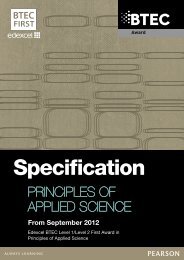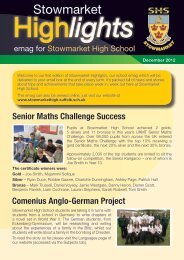BTEC First Award in Application of Science - specification - Edexcel
BTEC First Award in Application of Science - specification - Edexcel
BTEC First Award in Application of Science - specification - Edexcel
You also want an ePaper? Increase the reach of your titles
YUMPU automatically turns print PDFs into web optimized ePapers that Google loves.
UNIT 6: APPLICATIONS OF PHYSICAL SCIENCE<br />
Teacher guidance<br />
Resources<br />
There are no special resources needed for this unit.<br />
Assessment guidance<br />
This unit is assessed <strong>in</strong>ternally by the centre and externally verified by <strong>Edexcel</strong>.<br />
Please read this guidance <strong>in</strong> conjunction with Section 8 Internal assessment.<br />
The content <strong>of</strong> this unit should be approached from a practical po<strong>in</strong>t <strong>of</strong> view as far as<br />
possible, e.g. through scientific <strong>in</strong>vestigative assignments.<br />
Level 1 exemplifies partial achievement with<strong>in</strong> a level 2 learn<strong>in</strong>g aim.<br />
Learn<strong>in</strong>g aim A: Investigate motion<br />
The follow<strong>in</strong>g <strong>in</strong>vestigations are examples that could be carried out to enable learners<br />
to ga<strong>in</strong> evidence to achieve the appropriate assessment criteria:<br />
● <strong>in</strong>vestigate vehicle motion<br />
● <strong>in</strong>vestigate thrill-seek<strong>in</strong>g experiences, e.g. rollercoaster rides<br />
● <strong>in</strong>vestigate objects mov<strong>in</strong>g through different liquids or gases<br />
● <strong>in</strong>vestigate energy changes affect<strong>in</strong>g transportation and stopp<strong>in</strong>g distance.<br />
At level 1, learners are expected to carry out simple <strong>in</strong>vestigations, the conclusions <strong>of</strong><br />
which should be clear from direct observations with no process<strong>in</strong>g <strong>of</strong> data.<br />
At level 2, learners are expected to design and carry out more complex <strong>in</strong>vestigations<br />
that require process<strong>in</strong>g <strong>of</strong> data before a conclusion can be made.<br />
To achieve 1A.1, learners are expected to produce graphs us<strong>in</strong>g primary data from<br />
simple uniform motion experiments as shown <strong>in</strong> the content A.6 for uniform motion.<br />
To achieve 2A.P1, learners are expected to extend the <strong>in</strong>vestigation they carried out<br />
<strong>in</strong> 1A.1 and <strong>in</strong>clude graphs for non-l<strong>in</strong>ear/non-uniform motion.<br />
For 1A.2, learners must measure distance for simple experiments, along with their<br />
units that will be recorded dur<strong>in</strong>g the <strong>in</strong>vestigation.<br />
For 2A.P2, learners must use measurements from experiments and use the correct<br />
formulae and units to calculate speed and velocity.<br />
For 2A.M1, learners need to be able to <strong>in</strong>terpret graphs to enable them to<br />
label/identify which objects are stationary, mov<strong>in</strong>g at constant speed and mov<strong>in</strong>g at<br />
an <strong>in</strong>creas<strong>in</strong>g or decreas<strong>in</strong>g speed.<br />
For 2A.D1, learners need to use their distance–time and speed–time graphs <strong>in</strong> order<br />
to work out the gradient <strong>of</strong> any slopes. Additionally speed–time graphs should be<br />
used to work out the area under the graph.<br />
For 1A.3, learners need to be able to carry out simple energy conservation<br />
experiments and draw energy transformation diagrams.<br />
For 2A.P3, this needs to be extended to describ<strong>in</strong>g the conservation <strong>of</strong> energy and<br />
apply<strong>in</strong>g this to energy transformation diagrams.<br />
For 2A.M2, learners need to calculate k<strong>in</strong>etic energy and changes <strong>in</strong> gravitational<br />
potential energy <strong>in</strong> simple situations us<strong>in</strong>g appropriate formulae and units.<br />
For 2A.D2, learners must expla<strong>in</strong> how changes <strong>in</strong> energy will affect transportation<br />
and stopp<strong>in</strong>g distances.<br />
58<br />
BF029957 – Specification – <strong>Edexcel</strong> <strong>BTEC</strong> Level 1/Level 2 <strong>First</strong> <strong>Award</strong> <strong>in</strong> <strong>Application</strong> <strong>of</strong> <strong>Science</strong> –<br />
Issue 1 – March 2012 © Pearson Education Limited 2012








